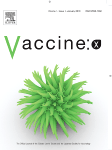Ver ítem
- xmlui.general.dspace_homeCentros e Institutos de InvestigaciónCICVyA. Centro de Investigación en Ciencias Veterinarias y AgronómicasInstituto de PatobiologíaArtículos científicosxmlui.ArtifactBrowser.ItemViewer.trail
- Inicio
- Centros e Institutos de Investigación
- CICVyA. Centro de Investigación en Ciencias Veterinarias y Agronómicas
- Instituto de Patobiología
- Artículos científicos
- Ver ítem
Reduction of foot-and-mouth disease virus transmission in cattle vaccinated one or two weeks before challenge using a commercial polyvalent vaccine
Resumen
Immediate vaccination of the most susceptible and epidemiological relevant animals is a crucial part of control measures that facilitate virus elimination in case of entry of foot-and-mouth disease (FMD). The objective of this study was to evaluate the effect of cattle vaccination 7 and 14 days prior challenge using a vaccine commonly applied in systematic vaccination campaigns against transmission of FMD virus (FMDV). Transmission of FMDV was
[ver mas...]
Immediate vaccination of the most susceptible and epidemiological relevant animals is a crucial part of control measures that facilitate virus elimination in case of entry of foot-and-mouth disease (FMD). The objective of this study was to evaluate the effect of cattle vaccination 7 and 14 days prior challenge using a vaccine commonly applied in systematic vaccination campaigns against transmission of FMD virus (FMDV). Transmission of FMDV was investigated in three groups of ten cattle each: one non-vaccinated group and two groups that were either vaccinated 7 days (−7/vaccinated group) or 14 days (−14/vaccinated group) before intranasal (IN) inoculation. Five cattle heads from each group were inoculated using the IN-route with the A/Argentina/2001 FMDV strain, while the remaining five cattle heads of each group were contact-exposed to inoculated cattle. Clinical signs were recorded; virus isolation and genome detection by RT-PCR were carried out on oesophageal–pharyngeal fluid (OPF) and blood. Neutralizing antibody titers and antibodies against non-structural proteins (NSP) of FMDV were also determined. Results suggest that the experimental design, virus challenge dose, and virus infectivity were appropriate and that the virus had been transmitted to naïve calves. Under the outlined experimental conditions, vaccination 7 and 14 days prior to challenge induced full clinical protection against virus inoculation. Moreover, −7/ or −14/vaccinated calves that had been contact-exposed to −7/ or −14/vaccinated IN-challenged calves, did not become infected. Consequently, no virus transmission occurred from vaccinated and subsequently infected calves to cohabitating vaccinated calves (R = 0). According to our results, early vaccination during an outbreak is effective as virus transmission can be significantly reduced using a vaccine commercially available, routinely applied in systematic vaccination campaigns.
[Cerrar]

Autor
Duffy, Sergio;
Fondevila, Norberto Antonio;
Galdo Novo, Sabrina;
Aznar, Maria Natalia;
Garro, Carlos Javier;
Smitsaart, Eliana;
Monti, Gustavo;
Fuente
Vaccine: X 5 : 100063 (August 2020)
Fecha
2020-08
Editorial
Elsevier
ISSN
2590-1362
Formato
pdf
Tipo de documento
artículo
Palabras Claves
Derechos de acceso
Abierto
 Excepto donde se diga explicitamente, este item se publica bajo la siguiente descripción: Creative Commons Attribution-NonCommercial-ShareAlike 2.5 Unported (CC BY-NC-SA 2.5)
Excepto donde se diga explicitamente, este item se publica bajo la siguiente descripción: Creative Commons Attribution-NonCommercial-ShareAlike 2.5 Unported (CC BY-NC-SA 2.5)


